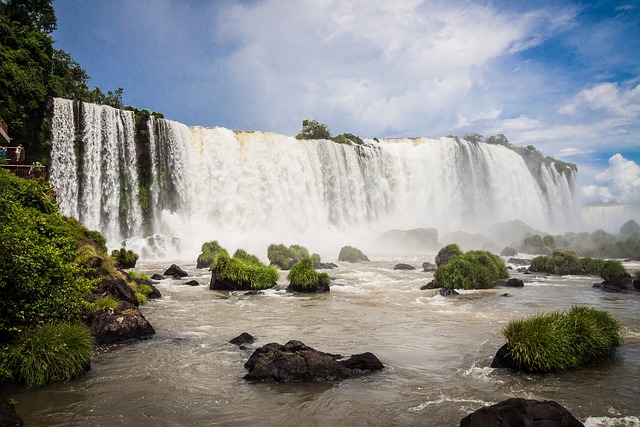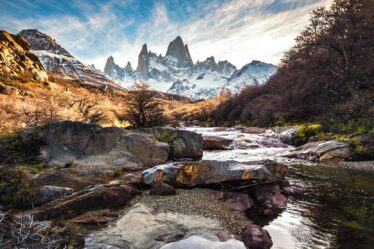
Nestled in the lush rainforests of South America, Iguazu Falls stands as one of the most breathtaking natural wonders in the world. This colossal cascade of waterfalls stretches across the border between Argentina and Brazil, offering a spectacular display of nature’s power and beauty. The falls are a UNESCO World Heritage site and are renowned for their sheer size, dramatic vistas, and diverse ecosystems. This article provides an in-depth exploration of Iguazu Falls, including its history, geography, visitor experiences, and practical tips for making the most of your visit.
Geography and Formation
Geographical Setting
Iguazu Falls is located in the tri-border area where Argentina, Brazil, and Paraguay converge. The falls are positioned within the Iguazu National Park in Argentina and the Iguaçu National Park in Brazil. The Iguazu River, which originates in Brazil, plunges over the Paraná Plateau to create the falls, which span approximately 2.7 kilometers (1.7 miles) in width.
Formation
The formation of Iguazu Falls is a result of volcanic activity that occurred millions of years ago. Lava flows created the rugged landscape, and erosion from the Iguazu River carved out the deep gorge that now houses the falls. The area is characterized by basaltic cliffs, lush rainforests, and numerous islands that divide the waterfalls into multiple tiers.
Overview of the Falls
Size and Scope
Iguazu Falls consists of around 275 individual waterfalls, with the most impressive being the Garganta del Diablo (Devil’s Throat). The falls vary in height from 60 to 82 meters (197 to 269 feet), with the total width of the waterfall system stretching approximately 2.7 kilometers (1.7 miles). The sheer scale and volume of water cascading over the edge create a thunderous roar that can be heard from miles away.
Key Features
- Garganta del Diablo (Devil’s Throat): The largest and most iconic of the falls, where the majority of the water plunges into a deep, U-shaped gorge.
- San Martin Falls: A prominent waterfall located on the Argentine side, known for its powerful flow and scenic surroundings.
- Floriano Falls: One of the major falls on the Brazilian side, offering panoramic views and excellent photo opportunities.
- Brazo San Martín: A section of the falls characterized by its sweeping cascades and lush vegetation.
Activities and Experiences
Argentina Side: Iguazu National Park
1. Walkways and Viewing Platforms
The Argentine side of the falls offers an extensive network of walkways and viewing platforms that provide close-up views of the waterfalls. The Upper Circuit (Circuito Superior) allows visitors to view the falls from above, while the Lower Circuit (Circuito Inferior) takes visitors closer to the base of the falls, offering a more immersive experience.
2. Garganta del Diablo
The Garganta del Diablo is the most spectacular part of the falls, and a walkway extends out into the midst of this dramatic feature, offering breathtaking views of the cascading water and mist.
3. Boat Tours
For a thrilling adventure, visitors can take a boat tour that brings them close to the base of the falls, where they experience the powerful spray and roar of the water. These boat rides provide a unique perspective of the falls and are a popular activity for those seeking excitement.
4. Wildlife Watching
Iguazu National Park is home to a diverse array of wildlife, including toucans, coatis, and capuchin monkeys. The park offers guided tours that focus on the rich flora and fauna of the region, providing opportunities to spot wildlife in their natural habitat.
Brazil Side: Iguaçu National Park
1. Walkways and Viewing Platforms
The Brazilian side of the falls features a series of elevated walkways and viewing platforms that offer panoramic views of the entire waterfall system. The main viewpoints provide sweeping vistas of the falls and the surrounding rainforest.
2. Helicopter Tours
For a bird’s-eye view of Iguazu Falls, visitors can take a helicopter tour that offers a unique perspective of the vast waterfall system and the surrounding landscape. This experience provides stunning aerial views and excellent photo opportunities.
3. Macuco Safari
The Macuco Safari is an adventure tour that combines a jeep ride through the rainforest with a boat ride that takes visitors close to the base of the falls. This exciting experience offers a combination of sightseeing, wildlife watching, and thrilling boat rides.
4. Bird Park
The Parque das Aves (Bird Park) is located near the entrance to Iguaçu National Park and features a variety of bird species native to the region. Visitors can walk through large aviaries and observe birds up close, including toucans, parrots, and harpy eagles.
Practical Information
Best Time to Visit
The best time to visit Iguazu Falls is during the dry season, which typically runs from May to September. During this period, the weather is more favorable for outdoor activities, and the falls are less likely to be affected by heavy rain. However, the falls are impressive year-round, and even during the rainy season, they can offer a dramatic and powerful display.
Entry Requirements
Visitors can access Iguazu Falls from both Argentina and Brazil, and it is possible to visit both sides of the falls with a combined ticket. Be sure to check visa requirements for each country, as travelers may need separate visas to enter Argentina and Brazil.
Getting There
- Argentina Side: The nearest airport to the Argentine side of the falls is Cataratas del Iguazú International Airport (IGR), located about 20 kilometers (12 miles) from the park. From the airport, visitors can take a taxi or shuttle to the park entrance.
- Brazil Side: The nearest airport to the Brazilian side is Foz do Iguaçu International Airport (IGU), located about 15 kilometers (9 miles) from the park. Transportation options include taxis, shuttle services, and rental cars.
Accommodation
There are several accommodation options available near both the Argentine and Brazilian sides of the falls. Options range from luxury hotels and lodges to budget-friendly guesthouses and hostels. Some popular choices include:
- Argentina Side: Gran Meliá Iguazú, Loi Suites Iguazú Hotel, and Yacutinga Lodge.
- Brazil Side: Belmond Hotel das Cataratas, Bourbon Cataratas do Iguaçu, and Mabu Thermas Grand Resort.
Conservation and Sustainability
Both Iguazu National Park and Iguaçu National Park are committed to preserving the natural beauty and ecological integrity of the falls and surrounding areas. Conservation efforts focus on protecting the diverse flora and fauna, managing visitor impacts, and promoting sustainable tourism practices.
Environmental Impact
Visitors are encouraged to follow park guidelines, respect wildlife, and minimize their environmental footprint. Both parks have implemented measures to reduce waste, conserve water, and protect the delicate ecosystems surrounding the falls.
Conclusion
Iguazu Falls, straddling the border between Argentina and Brazil, is a natural wonder that captivates visitors with its sheer scale, stunning beauty, and powerful presence. Whether exploring the lush rainforests of Argentina or enjoying panoramic views from Brazil, visitors are treated to a truly unforgettable experience. From thrilling boat rides and wildlife encounters to scenic walks and breathtaking viewpoints, Iguazu Falls offers a myriad of opportunities to connect with one of the world’s most spectacular natural wonders. Whether you seek adventure, relaxation, or simply the awe-inspiring beauty of cascading water, Iguazu Falls promises an experience that will leave you with lasting memories.


